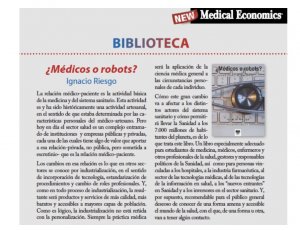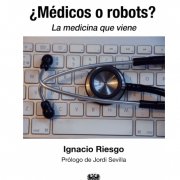What is meant by industrialization of medicine

New Medical Economics magazine has presented me with an interesting challenge, which I would like to thank them for most sincerely. To summarize the contents of my recent book “Doctor or robots? What lies ahead in medicine ” in about 800 words. [1]. Given that the book has nine chapters and more than three hundred pages, you can understand that the task is not easy.
The book’s title may confuse, but what it is about, in essence, is the industrialization of medicine.
It is part of the realization that medicine and health are today a major economic sector but whose core activity, the doctor / patient relationship is still handmade, that is, influenced by the personal characteristics of the artisan, in this case the doctor.
This, in pre-industrial times, in which the doctor / patient relationship was practically the only healing activity, it was understandable. I’m a man who is alone with another man, as on a desert island, said a famous Berlin clinician in the nineteenth century. But it so happens that, in recent times, the patient/ doctor relationship remains the core business of medicine, albeit now surrounded by a very diverse set of institutions and public and private companies (administrations, insurers, pharmaceutical companies, medical technology companies , hospitals, several laboratories, etc.). A whole complex sector in industrialized countries that ranges between 9-10% of GDP (18% in the US). Hardly a desert island, this doctor / patient relationship is now more like the crowded cabin of the Marx brothers in the famous movie “A Night at the Opera”.
There is a possible contradiction between this major industrial sector and the core business on which it is based, that is the doctor / patient relationship, determining largely, quality and cost of the offered care.
How will this great sector be established on a craft- based activity? As the industrial sector, institutions, companies, and patients require predictability in quality and costs, exactly what the artisanal sector cannot offer. So we say that in medicine industrialization occurs late in relation to other sectors.
What is industrialization ? Let’s start backwards, by what it is not. The word industrialization is a simple word that scares doctors , who often interpret it as depersonalization. But nothing could be further from the truth. Medicine is and always will be the application of general medical science to the characteristics and preferences of each individual.
What then is industrialization in medicine? It is the transformation that occurs in the doctor / patient relationship as a result of three phenomena: incorporation of technology, standardization of processes and change in professional roles.
The patient/ physician relationship will remain a private, not public, relationship, but, and here’s the big change, under scrutiny. The doctor no longer responds only to himself and to colleagues like in traditional professionalism, but to the set of institutions and companies operating in the health sector, that without being physically present in the doctor / patient relationship, bring value to the same and have a right to know and assess both the quality and the cost generated as a result of such relationship. The electronic medical record allows this scrutiny, impossible to do when the doctor / patient relationship was hidden in paper.
Of the three major components of the industrialization of medicine, the most difficult to accept and implement, and which will encounter greater resistance is the change of professional roles. It will be much easier to incorporate technology and process standardization. We assume that many of the tasks that are actually carried out by a doctor can be replaced by machines (computers and robots) and others can be carried out by many other professionals, mainly nurses. So, what is left as the doctor’s role? Something fundamental: communication with the patient and the orientation of complex cases. The doctor must engage in “narrative medicine,” helping patients to develop their own narrative of their illness. The great efficiencies we see in some Indian health institutions (Aravind, Apollo, etc.), which manage to carry out certain interventions at less than a tenth of the cost in Western countries, are brought about, precisely, by the judicious use of medical work, replacing what may be substituted by the work of other professionals.
This is the book. To situate this great change in the history of medicine; analysis of the drivers of this change; and its profound impact on professionals, institutions and health policy.
[1] Ignacio Riesgo
¿Doctors or robots ? What lies ahead in medicine.
Editorial Rasche, 2015




